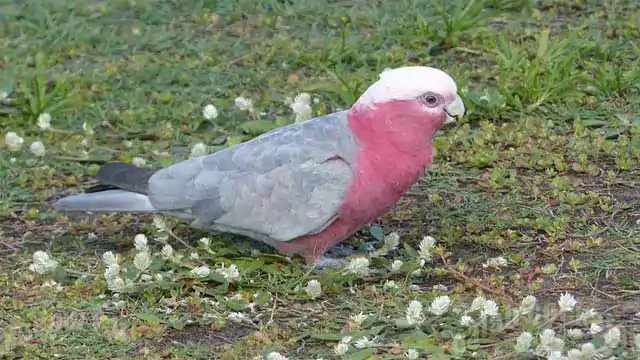Galah Cockatoo Bird Species Profile

Description of the Galah Cockatoo
Contents:
Common names
Scientific name
Origin and history
Volume
Average lifespan
The mood
Rose-breasted cockatoo (Galah Cockatoo) color and marking
Rose is taking care of the breasted cockatoo
Rose Breasted Cockatoo Feeding
Exercise
General health problems
The rose-breasted cockatoo, commonly known in its native Australia as Galah, maybe close to the breed in terms of fit-fit for an owner who likes to play a lot with a pet. Highly intelligent and with a lot of human love, birds can easily learn a simple vocabulary when trained as well as learn other complex techniques. As a native of the harsh conditions of Central Australia, the rose-breasted cockatoo is also unusually difficult and free from other common diseases and disorders.
Common names
The Galah Cockatoo (rose-breasted cockatoo) is also known as the throat, throat cockatoo, pink and gray cockatoo, the crimson-breasted cockatoo, the pink cockatoo, and the throat.
Scientific name
The root name for the Rose-breasted cockatoo (Galah Cockatoo) is Ilophus roseicapillus. There are three subspecies with slight color and size variations: Ellophus roseicapilus biceps (southeast form), e. R. Pinkicapilla (Western Australian form), and e. Skulls (found throughout the northern part of Australia).
Origin and history
Galah Cockatoo (Rose-breasted cockatoo) is a native of Australia, where it can be found in open areas in most areas of the country. The country is absent only from the arid region, and it has become self-established in Tasmania. Galah cockatoo is commonly found in large herds, often in groups that also include sulfur-crested cocktails. Rose-breasted cockatoos are a familiar sight even in urban areas — so that they are sometimes a rarity.
Galah cockatoo is more prevalent in livestock areas as they eat cultivated crops and use artificial ponds and drink tanks for livestock. For farmers, these birds are sometimes regarded as harmful.
Volume
A mature pink-breasted cockatoo is usually 12 to 15 inches taller than the tip of ants. It usually weighs between 10 and 14 ounces.
Average lifespan
Galah Cockatoo (Rose-breasted cockatoo) can live up to 70 years in captivity, but the average life expectancy is about 40 years.
The mood
Affectionate and friendly, pink breasted cockatoo has a reputation for being a loving pet. It is a sensitive bird but requires attention and interaction from its owners. Owners of rose-breasted cocktails need to make sure they spend a lot of time with their new pets. It is a feather-bird in nature, and if it were adopted by its flock, the rose-breasted cockatoo would become ruthless or angry.
Galah cockatoo color and marking
Galah Cockatoo (Rose-breasted cockatoos) have bright pink feathers on their chests, bellies and half under their mouths. They have pink-white crests and gray backs, wings, and tail feathers. They have gray feet and horny beak. As is true of all cockatoos, the rose-breasted has a head crest that immediately elevates when the bird is scared or excited.
Caring for galah cockatoo
Their dark complexion and friendly personality have made rose-breasted cockatoos (Galah Cockatoo) increasingly popular as pets in recent years. Prospective owners should be aware that these are highly social birds that will treat their owners as members of the flock. Your bird will want to spend a considerable amount of time with you and will be a fairly high maintenance pet. If neglected or even occasionally overlooked, pink-breasted cocktails can be frustrating and destructive. These birds can be very happy to have another rose-beast as a cage companion.
Galah Cockatoo (Rose-breasted cockatoo) is not a particularly loud bird, and it usually limits its morning to early morning and early evening. These parrots need to be surrounded in a dark, quiet place that mimics the protection of the desired area in a wild environment. Many owners find that covering the bird’s cage reassures the bird.
It is not a large parrot species, but the rose-breasted cockatoo (Galah Cockatoo) still needs a lot of space. The size of a cage 4 x 4 x 4 feet should be considered a minimum.
galah cockatoo Feeding
Like all cockatoos, rose-breasted cockatoos are prone to weight gain, so be sure to monitor their fat intake. When eating large quantities of nuts and seeds and high-fat foods, these birds can develop fatty tumors.
When kept as pets, the rose-breasted cockatoo is usually mixed with seeds, nuts, dried fruits, and a balanced pot containing dried vegetables, but they should be provided with plenty of vegetables and fruits. Leafy vegetables such as bread chard, kale, Chinese cabbage, romaine and other lettuce such as bread vegetables, peppers, zucchini, greens, and sprouts are excellent for these birds. Allow them to eat fresh fruit regularly. Walnuts, nuts, and pecans can be used as training treats, but don’t overfeed your parrot with high-fat nuts. Freshwater should be available at all times.
Exercise
Rose-breasted cockatoo (Galah Cockatoo) are active birds and they need a lot of exercises to maintain their physical health. An owner should plan to give this bird out of the cage for 3 to 4 hours of active time per day. Cockatoos have strong beaks and jaws, so it is important to provide plenty of safe toys with wood or leather that allows them to practice their jaw muscles and satisfy natural chewing instincts. Toys are an important part of prosperity for these birds and changing them regularly will keep them interested and teach them to play freely.
General health problems
Galah Cockatoo (Rose-breasted Cockatoo) is similar to some other diseases and nutritional diseases like other vessels and Cockatoo. The most common conditions include fatty liver disease, lipoma, cytosine beak, and pulse disease (PBFD), feather-peeling and other forms of mutation.
But the most common problem with Galah Cockatoo (rose-breasted cockatoo) is obesity. This is almost always caused by very little activity combined with a diet that has too many calories. With plenty of exercises and a good, balanced diet, your pink breast cocktail can be healthy for all kinds of parrots.








